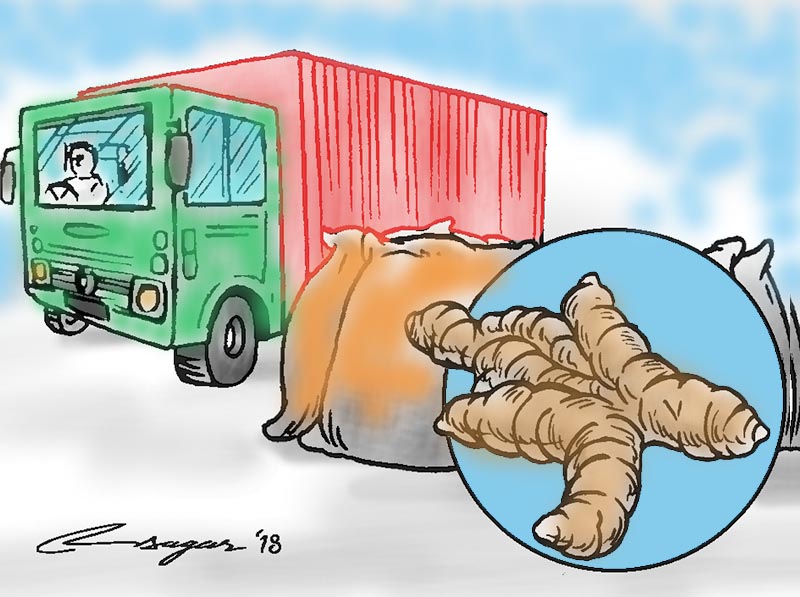Ginger in a pickle: Understanding export rules
With heavy concentration of ginger export to India on the one hand and little efforts on the part of Nepal government to build trade-related infrastructure to comply with technical requirements on the other, we are on the verge of losing a major market
In January 2018, several truckloads of ginger ready for export to India got stranded at Indo-Nepal border in Kakarbhitta after India refused entry citing lack of compliance with Sanitary and Phytosanitary (SPS) requirements. Earlier also exports of the hot, fragrant spice to the southern neighbour were halted after Indian authorities said that the ginger exported from Nepal “had excess pesticide residue and was sometimes mixed with Chinese ginger”.
Nepal is the third largest producer of ginger in the world (FAOStat, 2013). Ginger is also one of the 12 products identified by Nepal Trade Integration Strategy (NTIS) 2016 as having high export potential. In 2016/17, Nepal exported ginger worth Rs 243 million. The export of ginger from Nepal is heavily concentrated to India with 99 per cent of the export quantity going there (Department of Customs, 2017). However, the export of ginger to India faced a significant slump by 62 per cent last fiscal, largely due to intermittent export bans by India.
First and foremost, we need to understand three important aspects with respect to the use of Non-Tariff Measures (NTMs) in international trade. First, the General Agreement on Tariffs and Trade of the World Trade Organisation (WTO) has set out standard provisions for countries to practise NTMs such as SPS measures and Technical Barriers to Trade (TBT) to which Nepal, as a WTO member, must abide by. Second, NTMs are disguisedly being used as a protectionist measure by countries in the name of safety and protection of human, animals and plant health, and are increasingly used as substitute to tariffs.
According to a survey conducted by the International Trade Centre (ITC) in 2017, the largest number of difficult NTM cases reported by Nepali exporters is of Indian regulations or procedures which account for 18 per cent of the burdensome NTM cases. With regards to ginger, 86 per cent of ginger exporters complained that they were affected by burdensome NTMs. Third, and surprisingly, only 13 per cent of problems faced by the Nepali exporters are due to strict regulations and difficulty in complying with them. In the contrary, 73 per cent of NTMs pose problems because of various procedural obstacles, most of which occur within Nepal itself, such as unavailability of testing and certification facilities and test results from Nepal not being accepted in partner countries (ITC, 2017).
Our country lacks an internationally accredited testing laboratory due to which ginger shipments are required to undergo strict testing at the Central Food Laboratory (CFL) in Kolkata, India, which takes a longer time—up to 75 days, hampering the product freshness (ITC, 2017). Tests conducted by the Nepal Bureau of Standards and Metrology (NBSM) and Department of Food Technology and Quality Control (DFTQC) are not recognised by India.
On top of it, Nepal is exporting soil-laden ginger due to underutilisation of the existing washing plants in the country. Quarantine rules of India do not allow ginger with soil content. Ginger exporters also complain of administrative hurdles at the border like shipments with value in excess of Rs 1 million must have the customs bill signed by the Indian Assistant Commissioner. Exporters have to travel to Siliguri for the signature. Nepal has little infrastructure to meet the NTM requirements. Nepal, as a WTO member, has no option than to comply with regulations. Simply condemning Indian moves will yield no result. Hence, there lies a major question: even after repeated incidence of bans on ginger export, what preparations have been done on the domestic front?
The government needs to make serious efforts towards international accreditation of labs in Nepal with the cooperation from the Indian government. The Ministry of Commerce (MoC) together with Nepal Ginger Producers and Traders Association should train Nepali farmers on Good Agricultural Practices (GAP) to comply with the requirement of Hazard Analysis and Critical Control Point. It is also crucial for the Ministry of Agricultural Development (MoAD) to create an authentic database of ginger production starting from the pre-harvesting period. The database can be used for making decisions on the amount of domestic consumption and exports. Meanwhile, the Federation of Nepalese Chamber of Commerce and Industries and NGTPA should ensure that the rules of origin are adhered to and certificates of origin are not misused.
With heavy concentration of ginger export to India on the one hand and little efforts on the part of Nepal government to build trade-related infrastructure to comply with technical requirements on the other, we are on the verge of losing a major market for our product. The concerned stakeholders, including the government and the private sector, must make efforts to build infrastructures that make us capable of complying with WTO regulations. The government should not hesitate to seek support from Enhance Integrated Framework under the WTO, Food and Agriculture Organisation and ITC. The government must proactively engage in diplomatic efforts with India to relax the stringent NTMs on the Nepali products and remove the procedural and administrative obstacles.
Sharma is a national consultant at International Trade Centre and Shrestha is a research assistant at LDC Watch






